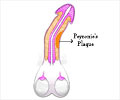In patients recovering surgical repair of retinal detachment in the eye, a condition called proliferative vitreoretinopathy (PVR) is a serious, sight-threatening complication.

"We found that a combination of 7 classes of growth factors and cytokines was essential for PVR to develop in an animal model of the disease," explains lead investigator Andrius Kazlauskas, PhD, of The Schepens Eye Research Institute and the Department of Ophthalmology, Harvard Medical School. "By neutralizing them, we prevented PVR-relevant signaling, and inhibited contraction of collagen gels containing primary retinal pigment epithelial cells derived from a human PVR membrane (RPEMs). These findings suggest a potential therapeutic approach to reduce the incidence of PVR in patients undergoing surgery to repair a detached retina."
In animal models, platelet-derived growth factor receptor α (PDGFRα) is associated with PVR and strongly promotes experimental PVR. Vitreal growth factors outside of the PDGF family promote an indirect route to activate PDGFRα. Importantly, indirectly activated PDGFRα engages a characteristic set of signaling events and cellular responses that are tightly associated with PVR. This study sought to identify the factors that would induce those events, and develop therapeutic approaches to prevent patients from developing PVR.
Vitreous was obtained from normal rabbits or those in which PVR was either developing or stabilized. Normal vitreous was found to contain substantial levels of growth factors and cytokines, which change quantitatively or qualitatively as PVR develops. A set of nine growth agents was found to be most abundant and therefore most likely to contribute to PVR. Neutralizing a subset of these factors in rabbit vitreous eliminated their ability to induce PVR-relevant signaling and cellular responses. A single dose of neutralizing reagents effectively protected rabbits from developing retinal detachment. "Our in vitro approach to characterize and neutralize vitreal bioactivity accurately predicted the efficacy of an in vivo therapy," notes Dr. Kazlauskas.
To identify growth factors likely to be driving PVR in humans, the investigators quantified the level of growth factors and cytokines from human donors that had either PVR, or a non-PVR retinal condition. Fourteen of the 24 agents quantified were present in large concentrations in PVR vitreous. Neutralizing just 7 of these prevented vitreous-induced activation of PDGFRα. Furthermore, the cocktail also suppressed the contraction of these cells in collagen. Therefore, the same neutralization strategy that prevented PVR in rabbits also prevented human PVR vitreous from inducing PVR-relevant responses. These results strongly suggest that a dose of neutralizing reagents may also protect humans from PVR.
"Although the outlook is encouraging, it would be useful to test the effectiveness of this treatment on alternate models of retinal detachment. It is also worth considering a combinatorial approach to therapy. For example, the antioxidant N-acetylcysteine (NAC) prevents retinal detachment in rabbits by blocking intracellular processes. A combined therapy involving the neutralization approach presented here with NAC treatment would doubly-target PVR at the extracellular and intracellular levels," concludes Dr. Kazlauskas.
Advertisement
Source-Eurekalert












